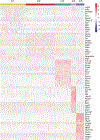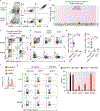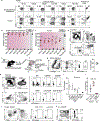Programme of self-reactive innate-like T cell-mediated cancer immunity
- PMID: 35444279
- PMCID: PMC9250102
- DOI: 10.1038/s41586-022-04632-1
Programme of self-reactive innate-like T cell-mediated cancer immunity
Abstract
Cellular transformation induces phenotypically diverse populations of tumour-infiltrating T cells1-5, and immune checkpoint blockade therapies preferentially target T cells that recognize cancer cell neoantigens6,7. Yet, how other classes of tumour-infiltrating T cells contribute to cancer immunosurveillance remains elusive. Here, in a survey of T cells in mouse and human malignancies, we identified a population of αβ T cell receptor (TCR)-positive FCER1G-expressing innate-like T cells with high cytotoxic potential8 (ILTCKs). These cells were broadly reactive to unmutated self-antigens, arose from distinct thymic progenitors following early encounter with cognate antigens, and were continuously replenished by thymic progenitors during tumour progression. Notably, expansion and effector differentiation of intratumoural ILTCKs depended on interleukin-15 (IL-15) expression in cancer cells, and inducible activation of IL-15 signalling in adoptively transferred ILTCK progenitors suppressed tumour growth. Thus, the antigen receptor self-reactivity, unique ontogeny, and distinct cancer cell-sensing mechanism distinguish ILTCKs from conventional cytotoxic T cells, and define a new class of tumour-elicited immune response.
© 2022. The Author(s), under exclusive licence to Springer Nature Limited.
Conflict of interest statement
Competing Interest
MSKCC has filed a patent application regarding use of ILTCk in cancer immunotherapy. MOL is an SAB member of and holds equity or stock options in Amberstone Biosciences Inc, and META Pharmaceuticals Inc.
Figures















Comment in
-
Self-reactive, innate-like T cells enhance cytotoxicity and immunosurveillance.Trends Cancer. 2022 Aug;8(8):629-631. doi: 10.1016/j.trecan.2022.05.003. Epub 2022 Jun 4. Trends Cancer. 2022. PMID: 35672242 Free PMC article.
-
Innate-like T cells: A promising asset in anti-cancer immunity.Cancer Cell. 2022 Jul 11;40(7):714-716. doi: 10.1016/j.ccell.2022.05.017. Epub 2022 Jun 16. Cancer Cell. 2022. PMID: 35714605 Free PMC article.
-
Cytotoxic FCER1G+ innate-like T cells: new potential for tumour immunotherapy.Signal Transduct Target Ther. 2022 Jun 29;7(1):204. doi: 10.1038/s41392-022-01061-4. Signal Transduct Target Ther. 2022. PMID: 35768418 Free PMC article. No abstract available.
References
-
- Zheng C et al. Landscape of Infiltrating T Cells in Liver Cancer Revealed by Single-Cell Sequencing. Cell 169, 1342–1356 e1316 (2017). - PubMed
-
- Simoni Y et al. Bystander CD8(+) T cells are abundant and phenotypically distinct in human tumour infiltrates. Nature 557, 575–579 (2018). - PubMed
-
- Zhang L et al. Lineage tracking reveals dynamic relationships of T cells in colorectal cancer. Nature 564, 268–272 (2018). - PubMed
-
- Zheng L et al. Pan-cancer single-cell landscape of tumor-infiltrating T cells. Science 374, abe6474 (2021). - PubMed
MeSH terms
Substances
Grants and funding
LinkOut - more resources
Full Text Sources
Other Literature Sources
Medical
Molecular Biology Databases
Research Materials
Miscellaneous

